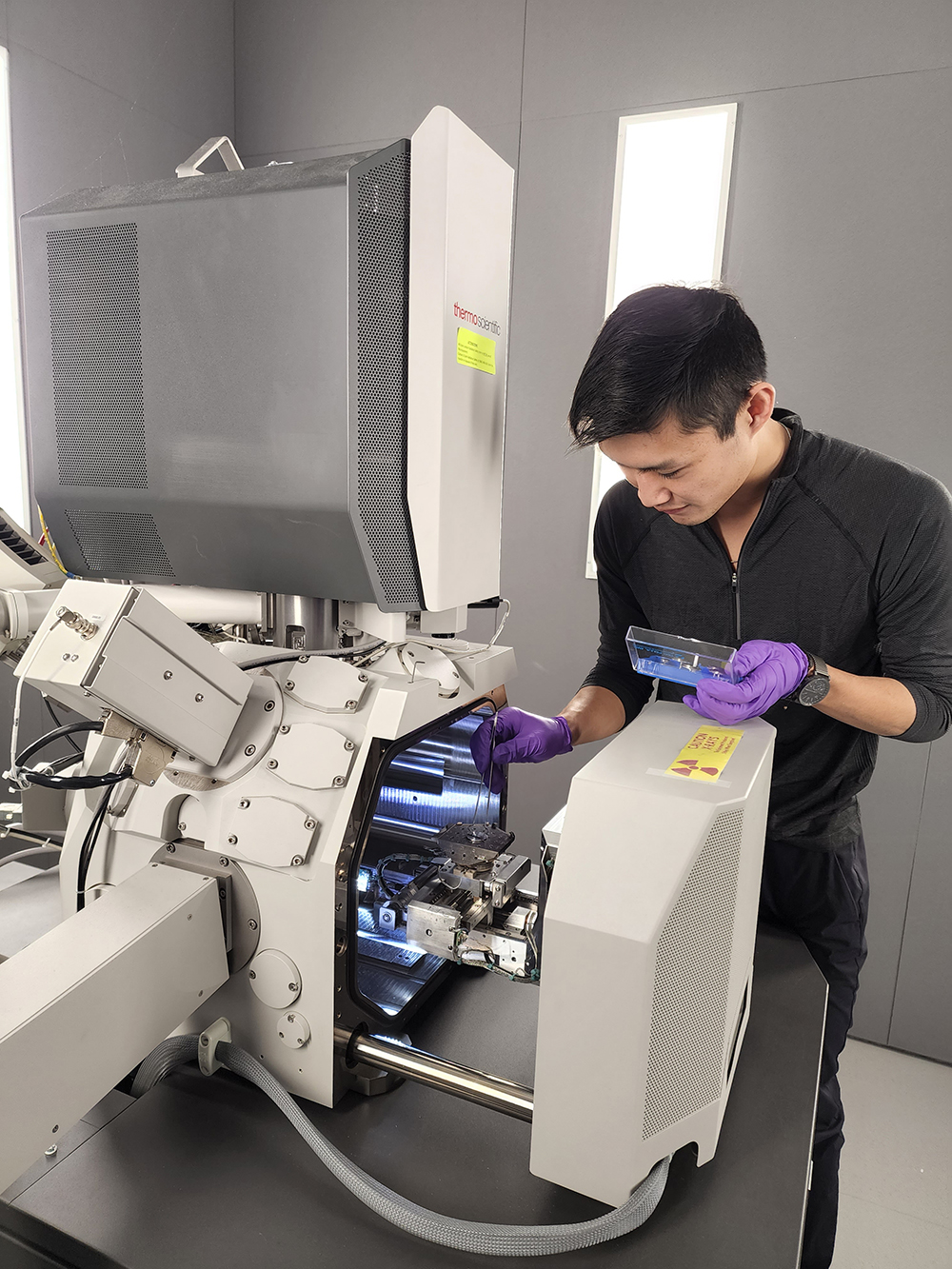Study MSE to Make a Difference in Your Interests
By Alec Arbia, Written Communications Assistant

Kyrus Tsai, MSE graduate student, loading a sample into the Teneo SEM at the Center for Advanced Microscopy and Materials Analysis (CAMMA) in the Innovation Partnership Building (IPB).
As an MSE graduate student who used to play division three tennis, Kyrus Tsai wants to use his research to advance the material components used in tennis rackets – but more on that later.
While he was an undergraduate at Calvin College in Grand Rapids, Michigan, Tsai obtained a BSE with a concentration in chemical engineering and a BS in chemistry. But knew early on that he wanted to pursue material science, and also a graduate degree. Since Calvin did not offer a materials program, Tsai jumped into MSE when he came to UConn for a PhD.
“UConn was doing a lot of interesting research and I liked the collaborative nature of the department both between groups and with industry partners. I also recall on my visit, it being mentioned that UConn had the fastest growing Materials program in the nation and that appealed to me,” Tsai remembers.
At UConn MSE, Tsai is currently working on materials characterization of additively manufactured metals by observing the microstructure of these builds using a range of microscopy techniques. “It is cool to be able to observe what makes a given material have its properties and get into those core details. The research allows me to understand the reasons why, and the effects the microstructure has on the overall component.”
When asked what he hoped the impact of this work will be, Tsai says, “I am hoping that what I am doing and what I am observing can be used to improve the relevant additive manufacturing processes. We’re giving information on how process parameters affect the microstructures and ultimately the efficacy of the resulting builds.”
Additive manufacturing (also known as 3D printing) is an ever-growing field. Tsai’s research helps him understand not only newly printed parts, but also damaged ones. Repairing these parts requires studying the connection point between the existing piece and the new addition to determine if the repair will be successful, and whether the part can continue to be used in the same manner.
Tsai describes the MSE faculty members and staff as “incredibly friendly and knowledgeable. . . The collaborative nature of the department has allowed me to get help from other advisors, and gave me insight into other projects and groups.”
Tsai is a member of Professor Mark Aindow’s microscopy group. As part of a major joint effort, he is also regularly updated on the work done in Professor Seok-Woo Lee’s micromechanical testing group and Professor Avinash Dongare’s computational group. “This really helps me to gain a deeper understanding of fields/topics I otherwise may not touch on in my own research. Having meetings where other research areas are discussed in detail gives insight in ways that occasional seminars or research papers I read cannot.”
Tsai is not only a talented academic – he also plays club volleyball on the side. “Being a student athlete is not only possible for undergraduates but graduates as well. I think that is something that is important and a game changer for me. I am so glad that I am able to play competitive sports again since it has always been such a big part of my life.”
When asked what he wants to do upon graduating from UConn, Tsai says he is interested in two different directions that ideally he would combine into one. “The first is advancing the field of something I am interested in by introducing novel materials to those that are commonly used.”
The second direction? Dealing with sustainability. “Being able to use recycled or upcycled materials is incredibly important in my mind. Pollution and waste are huge issues that need to be tackled. I think taking on this issue from a MSE perspective is key.”
Tsai admits he has long been interested in the evolution of tennis rackets throughout the past century. “The evolution from wood to metal to composites like carbon fiber and graphene has always been something that fascinated me.” Some have even incorporated piezoelectrics for vibration damping and ideally more powerful strokes—just ask Professor George Rossetti about developing such rackets which even got used at Wimbledon.
Perhaps sustainable and recyclable tennis rackets are not too far off in Kyrus Tsai’s future. “It would be awesome to be able to be a part of that sort of change.”
Published: March 3, 2023
Categories: 3D printing, additive manufacturing, graduate students, materials characterization, microscopy, news
Available Archives